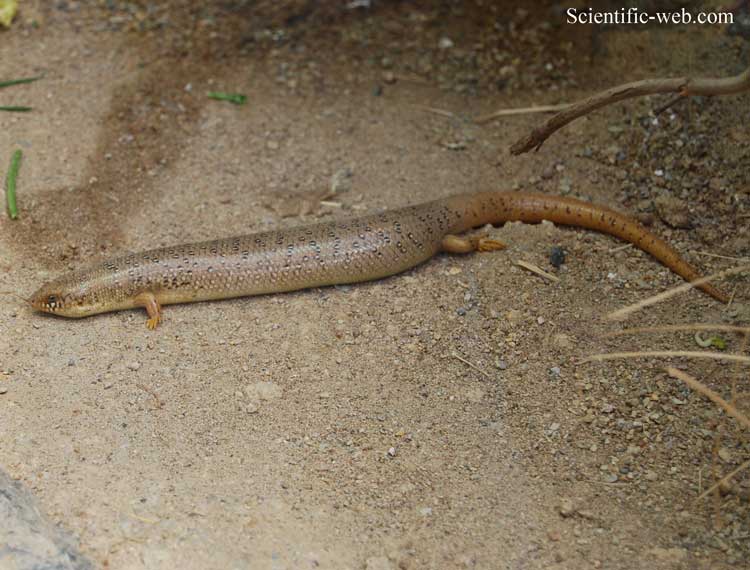
Chalcides ocellatus, Photo: Michael Lahanas
Superregnum: Eukaryota
Regnum: Animalia
Subregnum: Eumetazoa
Cladus: Bilateria
Cladus: Nephrozoa
Superphylum: Deuterostomia
Phylum: Chordata
Cladus: Craniata
Subphylum: Vertebrata
Infraphylum: Gnathostomata
Superclassis: Tetrapoda
Cladus: Reptiliomorpha
Cladus: Amniota
Classis: Reptilia
Cladus: Eureptilia
Cladus: Romeriida
Subclassis: Diapsida
Cladus: Sauria
Infraclassis: Lepidosauromorpha
Superordo: Lepidosauria
Ordo: Squamata
Subordo: Scincomorpha
Superfamilia: Scincoidea
Familia: Scincidae
Subfamilia: Scincinae
Genus: Chalcides
Species:Chalcides ocellatus
Subspecies (6): C. o. ocellatus – C. o. tiligugu – C. o. linosae – C. o. sacchii – C. o. subtypicus – C. o. zavattarii
Name
Chalcides ocellatus (Forsskål, 1775)
Holotype: unlocated.
Type locality: “Aegypto [=Egypt]”.
Combinations
Lacerta ocellata Forsskål, 1775: 13 [original combination]
Scincus ocellatus — Meyer, 1795: 30 [subsequent combination]
Mabuya ocellata — Fitzinger, 1826: 53 [subsequent combination]
Gongylus ocellatus — Wagler, 1830: 162 [subsequent combination]
Seps (Gongylus) ocellatus — Günther, 1871: 241 [subsequent combination]
Chalcides ocellatus — Boulenger, 1887: 400 [subsequent combination]
References
Primary references
Forsskål, P.S. 1775. Descriptiones animalium avium, amphibiorum, piscium, insectorum, vermium; quae in itinere orientali observavit. Post mortem auctoris edidit Carsten Niebuhr. Ex Officina Mölleri: Hauniae [=Copenhagen]. 1–20 + i–xxxiv + 1–164 + 1 map. BHL Reference page.
Additional references
Lavin, B.R. & Papenfuss, T.J. 2012. The phylogenetic position of Chalcides ocellatus (Squamata: Scincidae) from Yemen and Somalia. Zootaxa 3221: 26–36. Preview.
Links
Uetz, P. & Hallermann, J. 2022. Chalcides ocellatus. The Reptile Database. Accessed on 10 May 2019.
Vernacular names
English: Ocellated Skink
español: Eslizón ocelado
italiano: Gongilo
Ελληνικά, Κυπριακά : Χαλκίδης ο μικρόφθαλμος, Λιακόνι
Chalcides ocellatus, or the ocellated skink (also known as the eyed skink or gongilo[1]) is a species of skink found in Greece, southern Italy, Malta, Lebanon, and parts of northern Africa.[2][3][4] UAE, Israel,[5] It is also found in Pakistan, India and Sri Lanka.
Chalcides ocellatus
Description
As an adult, it generally reaches about 15 to 30 cm (6 to 12 in) of length with a 22 to 39 g weight[6] and has a small head, cylindrical body, and five toes on each foot. They are very agile and are often found in arid areas.[7] It is strongly related to Chalcides colosii, and C. colosii was formerly considered a subspecies of C. ocellatus.[8] C. ocellatus is notable for the presence of ocelli and for its wide variety of coloration patterns. Females of the species give birth to 2-6 live young through viviparity.
Chalcides ocellatus is considered to be a generalist species and can be found in a wide variety of environments, such as farmland and gravel deserts around the Mediterranean coast. Its main escape tactic from predators is to run behind vegetation, most likely because it is not suited to run very fast. Although this species has very smooth scales and is capable of "sand-swimming" behavior in loose sand or soil,[9] its limbs are not specifically adapted for fossorial movement.[10]
Diet
Ocellated skinks are primarily insectivorous. In the wild they have been recorded to eat a wide variety of insects, including locusts, crickets, ants, beetles, isopods, spiders, centipedes, and insect larvae. However, they are also known to occasionally eat small lizards, including their own young,[11] and the tails of young lizards are a regular finding in the stomach contents of Chalcides ocellatus.[12]
In captivity, ocellated skinks can be primarily fed on insect prey, but they also take certain commercial diets as well as occasional wet cat/dog food. Ocellated skinks are also known to eat small amounts of plant matter, such as finely chopped greens, flowers, and fruits.[13]
References
Digimorph from the NSF Library at UT-Austin, Chalcides ocellatus
Amphibians and Reptiles of Europe
Arikan, et al.. "An Investigation on the Blood-Serum Proteins of Chalcides ocellatus (Sauria: Scincidae) Populations from Southern Anatolia." Archived July 17, 2011, at the Wayback Machine Tr. J. Zool. 22 (1998) 175-177.
Baha el Din, Sherif (2006). A Guide to Reptiles & Amphibians of Egypt. Cairo: The American University in Cairo Press. ISBN 978-9774249792.
@EliShlezinger (23 October 2018). "נחושית עינונית נשרפה היום בשמורת גברעם. כ-120 דונם על האש. צווי כיבוי בסיוע 2 מטוסים ושופל השיגו שליטה. היום פרצו…" (Tweet) – via Twitter.
ARKive
"Fauna Import UK". Archived from the original on 2004-08-10. Retrieved 2007-11-11.
Schleich, Hans-Hermann, et al.. Amphibians and Reptiles of North Africa: Biology, Systematics, Field Guide. Koeltz Scientific Books, 1996.
Catena, Angeline M.; Hembree, Daniel I. (2014-09-25). "Swimming through the substrate: the neoichnology of Chalcides ocellatus and biogenic structures of sand-swimming vertebrates". Palaeontologia Electronica. 17 (3): 1–19. doi:10.26879/463. ISSN 1094-8074.
Omar Attum, Perri Eason and Gary Cobbs. "Morphology, niche segregation, and escape tactics in a sand dune lizard community", Journal of Arid Environments 68:4, 564-573 March 2007
Vladimír Cerha, Miroslav Kocián, Scinkové, varani a ještěrky, Polaris, Frenštát p.R., p. 85
"Sharing resources in a tiny Mediterranean island? Comparative diets of Chalcides ocellatus and Podarcis filfolensis in Lampione | Request PDF". ResearchGate. Retrieved 2021-09-21.
Healey, Mariah. "What Do Ocellated Skinks Eat?". ReptiFiles. Archived from the original on 2021-09-21. Retrieved 2021-09-21.
Retrieved from "http://en.wikipedia.org/"
All text is available under the terms of the GNU Free Documentation License

